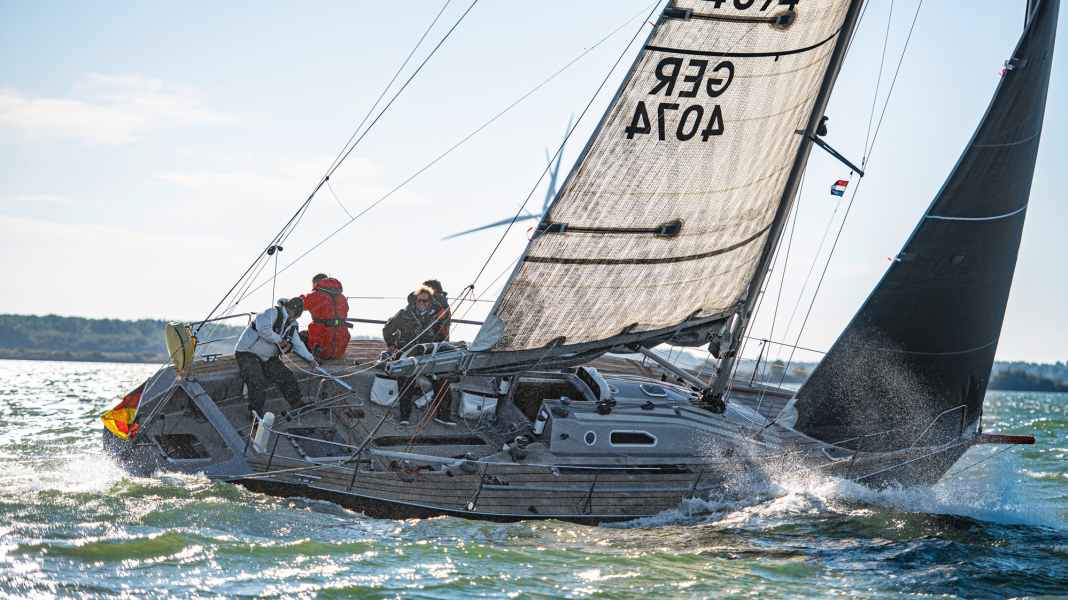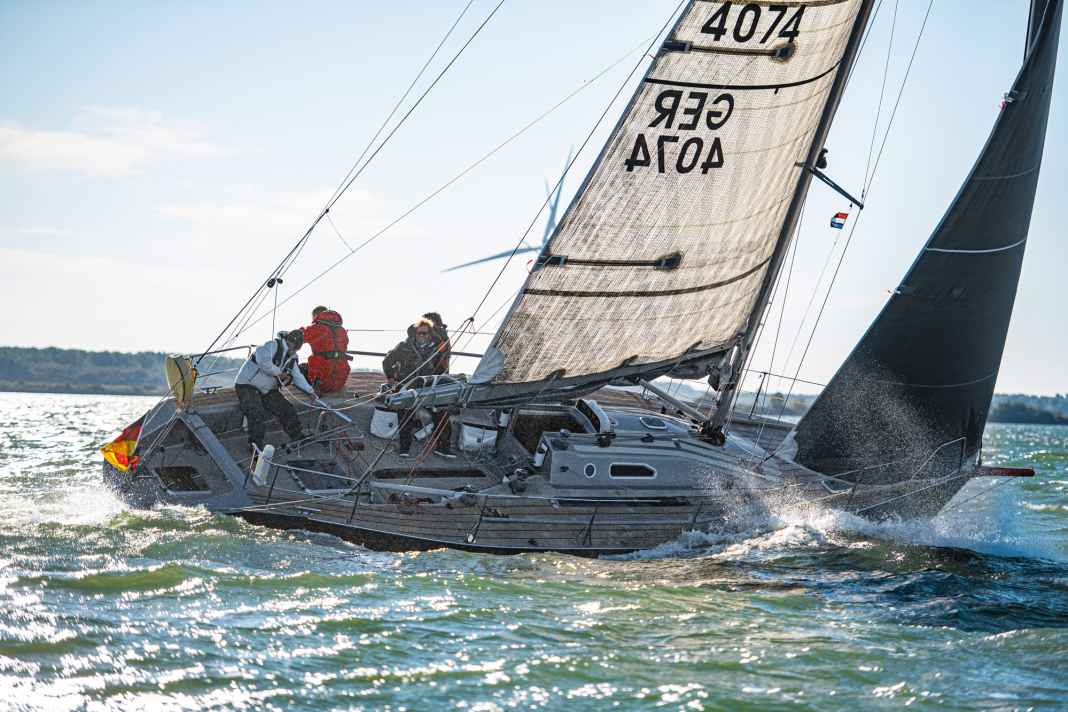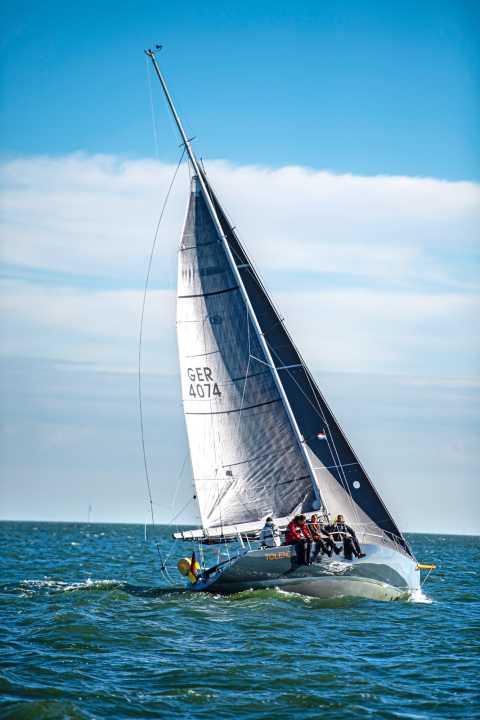One-tonne "New Yorker": Ex-Admiral's Cupper with rough edges is a relic of an era
Alexander Worms
· 13.04.2025







It is 1988, the GDR still exists, Margret Thatcher is in power in Great Britain, and a certain Gunnar Knierim is poking through the fog on the Baltic Sea with a ship recently completed at his parents' shipyard in Laboe after a few night shifts. The destination: Klintholm. The young shipbuilding prodigy is not alone on board; a warehouse worker from the owner's company is there to support him. "He slept below deck the whole time," reports Knierim today.
Also interesting:
The owner is Tilmar Hansen, at the time the owner of the New Yorker fashion chain. And that is also the name of the ship. It is to compete in the Admiral's Cup off Cowes a year later as part of the German team, thereby doing some advertising for the owner's company. And to test the ship, the plan is to compete in the Baltic Cup off Klintholm.
"We found Klintholm somehow, as GPS didn't exist yet. We had an AP navigator on board, which was really high-tech back then," continues Knierim. The "New Yorker" did quite well in the regattas, but narrowly missed out on qualifying for the 1989 Admiral's Cup the following year.
"For me personally, it was a good thing that we didn't qualify with the 'New Yorker'. I then slipped onto 'Becks Diva'. That was my introduction to big boat sailing. After that, I was still with Illbruck on various 'Pintas'," says Knierim, who will later build the only German America's Cupper to date at his shipyard. It was a bit of a shame for the "New Yorker", as the ship was one of four Judel/Vrolijk-designed monohulls built from carbon fibre sandwich with honeycomb core, which was also really high-tech at the time. The hull and deck were manufactured in the Westerwald by Schütz-Werke. Their owner, Udo Schütz, was also the owner of the ships called "Container". The ship was then fitted out for the Kiel owner by Knierim in Laboe.
Marriage of the IOR formula
The ship cost around 1.4 million Deutschmarks - a lot of money at the time. What's more, for a pure sports boat: hardly any interior fittings, all black, no cosiness and consistently designed into a formula that was dying out. "That was still the heyday of the IOR formula, but the 50-footer and the IMS formula were already on the horizon," explains Rolf Vrolijk. "Back then, you needed a new boat every two years if you wanted to be at the front of the Admiral's Cup," says the designer.
IOR had long since lost its way: Girth dimensions that made the hulls strangely round and allowed little volume in the stern, which worsened performance downwind. In addition, fin keels with little ballast, which required a lot of crew weight on the edge, filigree masts that only stayed up thanks to backstays, all of which made sailing within the formula exciting. All in all, however, the ships did not sail as well as ships could have done back then.
Facts and figures in the background
- The single-tonner weighs 6.3 tonnes: The designation has nothing to do with the actual weight, but stands for the measurement size.
- The sail carrying capacity is 5.3: The value is a ratio of sail area to weight and is in no way inferior to that of modern racers.
- 1.4 million D-Mark is what a high-quality racer in the single-tonne class cost in 1990.
- 4 victories in the Admiral's Cup for the German team: The "Rubin" was the most successful with three victories in 1973, 1983, 1985 and 1993.
- 2 years If a cupper was competitive at the wedding of IOR, then a new one had to be found.
The formula and thus the vehicles used on the water are so exhausted that ludicrous stylistic flourishes sometimes developed. A hollow stern that extended the waterline length and at the same time reduced the all-important girth, internal ballast because keel weight was not wanted, and the manic search for weight reduction.
On the "New Yorker", for example, this resulted in a titanium tiller - 20 times more expensive, but still only half the weight of a stainless steel one. These are all signs of the beginning of the end of the IOR era. This end comes in 1993: it is the last Admiral's Cup to be held according to IOR. As a swansong to their formula, the Germans present themselves with a narrow but well-deserved victory. After that, the Admiral's Cup becomes less and less important. The "New Yorker" also had an eventful life. She was never really convincing on the regatta course; but what to do with such a carbond without interior fittings, which doesn't even sail fast overall and needs a lot of expertise and weight on the high side and therefore a large and competent crew? Difficult to sell from a broker's point of view, at best. More like high-tech scrap.
The refit includes the engine, keel bomb, extension
This is precisely why the one-tonner, which has had various names in the meantime, has been on dry land for many years, from 2005 to 2013 in Rostock alone. But there are people who seem to be attracted by this strange mixture of decadence from a golden age of German sailing, difficult sailing handling and the brute charisma of the Eintonner.
This is because the ship, now called the "Silver Machine", is travelling from Rostock to Hamburg for an extensive refit. A new diesel engine is installed, 500 kilograms of ballast are flanged to the keel in the form of a bomb, and a kind of interior extension is added.
One double berth forward, two aft and a saloon with an engine in the centre, but with stanchions, a refrigerated locker and saloon benches. The electrics were also renewed. A fairly rudimentary galley is installed under the companionway. But what remains: The loo stands next to the mast and is open to all other rooms. The ship was later renamed "Tolenza" and given a bowsprit.
Love makes you blind
In this condition, freshly refurbished and made of carbon foam sandwich, the current owner Daniel Foerster found the ship in 2020 at the broker Michael Schmidt & Partner in Hamburg. "I was looking for a sailing boat and immediately fell in love with the lines. Such a classic, a ship with history. That's great, isn't it?" True love is blind, because there is a small catch: Foerster's sailing experience is limited to a few hours in an Opti in his youth and occasional trips on a relative's tonner.
You tend to think of something white from the large series with a solid mast and furling sails. A carbon one-tonner with a fragile rig and no real comfort below deck? To even look at such a boat with this sailing vita, let alone buy it, deserves the highest respect.
The single-tonner is stubborn under sail
A visit on board shows just how big a challenge it is to steer the "Tolenza". On the Markermeer, where the ship is moored today, the wind is blowing at a good 20 knots. During the trial run, the wind picks up strongly, gusting to a good 7 Beaufort across the land. There are a total of five sailors on board, which makes things quite exciting, as the frighteningly delicate mast makes it abundantly clear that it likes to be very well supported by the stays. That alone ties up two crew members permanently.
That leaves two for the mainsheet and foresheet, number five steers. Relaxed sailing is out of the question, "Tolenza" behaves like her sister ship from the old days. In other words: a real diva. Although she sits well on the rudder, she quickly dips to leeward in gusts - despite 500 kilograms of extra ballast - and somehow tilts forwards in a strange way over her large beam. The tiller seems to be constantly signalling an imminent sunshot: Sometimes there is pressure, then suddenly it is completely gone, and finally the profile grips again.
You can't really go into the sun, but there are other ways to feel comfortable. There is an obvious lack of weight aft to windward, where the crew normally rides out. Designer Vrolijk also sees the lack of edge weight as a problem and comments: "Due to the interior fittings and the additional ballast, the boat floats a tonne lower in the water. In addition, the lines in the stern have been strengthened and the dent is gone. It's no longer the design that we came up with back then. I can imagine that much of the agility of the past has been lost."
The forces on the single-tonner are great
On the test drive, the less pronounced agility is good news: the sheer variety of lines and winches causes initial confusion. The positions and the associated tasks first have to be found. However, this gets better with every manoeuvre. The cockpit itself is very well organised for working on the lines. The sloping coamings ensure a clear view forwards and optimum angles for the eight winches. Only the mainsheet and traveller are somehow running the wrong way round, so a rigger has to get to work and convert the endless line that adjusts the foot block.
In general: the rigger. It has become the new owner's best friend. The running rigging alone is enormous, the main halyard has a 1:2 ratio and is therefore almost 50 metres long. Then there are the backstays, other halyards, trim lines and so on. That adds up to a lot. But apart from the problems with the mainsheet, the handling is getting better and better. Eventually, the crew also dare to go up on the high edge. Then "Tolenza" shows where her roots lie. She doesn't like to go very high upwind, but when she's slightly shaken or at half wind, she really gets going. The ship lies well in its own waves with its bump, considerable mountains of water form at the bow and stern, and the tonner gets going.
That's impressive, because the forces are huge: more pressure from the rig cannot be relieved by speed. With the increasing wind, there are some pretty elemental forces at work at some point. But it's fun, because that's what the ship was designed for. On this occasion, you can see how much fun it could be to drive the boat around the regatta course with a well-rehearsed crew. Unfortunately, however, attempts to assemble significant fleets of such tonne boats on the starting line in Europe have so far failed. In England, quarter-tonne boats enjoy a certain popularity. No wonder: they can be driven by three people. This makes it easy to put together a crew at the weekend. It's a different story with ten sailors for a one-tonner.
Darkness reigns below deck
Back in the harbour and a look below deck. Darkness reigns there. The narrow superstructure with the mini windows in combination with the carbon fibre surfaces visible everywhere do not create too much cosiness in the dark cave. On the way to the foredeck, you have to climb over two carbon ring bulkheads, which provide stability in the mast area; the toilet is provisionally positioned between these bulkheads, completely open to the saloon. A tube that fulfils some kind of structural function protrudes from the centre of the forward berth. The aft berths are bounded on the outside by the black ship's side and on the inside by a plywood panel. A small washbasin under the companionway has to suffice for daily personal hygiene. Incidentally, washing up is also done there. Comfort is different.
Actually, you shouldn't buy a ship like this. It's expensive to run and not even really fast. You need a lot of crew. It is complicated to sail because of the rig. There are virtually no regattas for this class of boat. Due to the constraints of the formula, the interior space is hardly usable, the bow and stern areas are too narrow for comfort. No, a boat like this is pointless in the strictest sense. The harbour master in Muiderzand puts it in a nutshell: "We in Holland say: a ship for the neighbour. Kind of cool. But you're happy if it's not your own."
Nevertheless, a certain aura hovers over this vehicle: built so consistently for a single purpose, it commands respect. A relic of an era, not really an icon, but definitely a piece of sailing history. With rough edges and quirks. Hubris turned into form. Unreasonableness in coal. As a sailor, you are happy to forgive the shortcomings of a boat like this. You want to own it. Just like owner Daniel Foerster. A little crazy, okay. Perhaps a symbol of the eighties. And that's exactly why it's somehow fascinating.
Technical data of "New Yorker" single-tonner

- Design engineer: Judel/Vrolijk
- Building yard: Schütz-Werke/Knierim
- Material: Carbon honeycomb sandwich
- Year of construction: 1988
- Total length: 11,97 m
- Width: 3,92 m
- Depth: 2,20 m
- Displacement: 6,3 t
- Sail area on the wind: 97,0 m²
- Sail area spinnaker: 94,0 m²
The article was first published in 2022 and has been revised for this online version.

